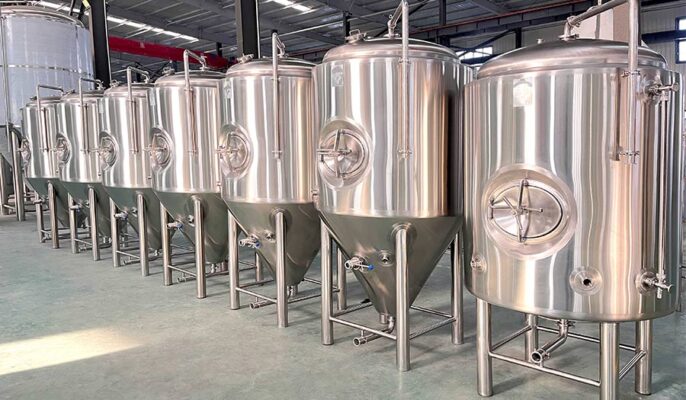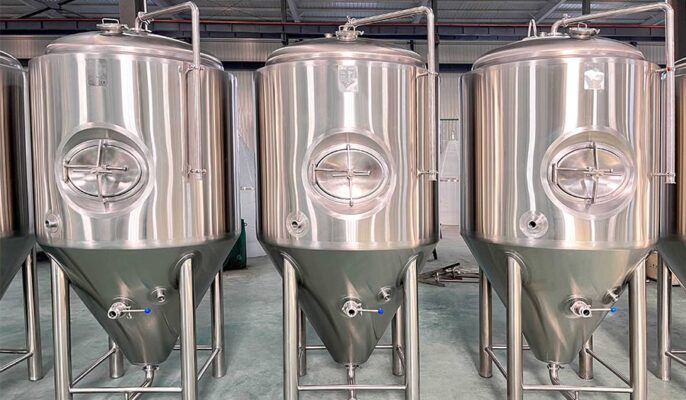発酵容器(FV)、または「発酵槽」は、酵母がビールへと発酵させる間、麦汁を貯蔵する場所です。麦汁(麦芽から抽出される糖分の多い液体)を、多くの人が楽しめる美味しく香り高い飲料に変える。醸造プロセスの要である発酵槽は、発酵の魔法を育む重要な役割を担っています。発酵槽には様々な形や大きさ、様々な素材があり、現在最もポピュラーなものはプラスチック、ガラス、ステンレススチールなどです。
とは何か? 発酵槽?
発酵槽は、発酵タンクや発酵容器としても知られ、発酵のために麦汁やブドウ果汁などの基質を保持するために使用される容器である。これらのタンクは、酵母やその他の微生物が糖をアルコールと二酸化炭素に変換するのに必要な環境を提供する。発酵槽では、さまざまな酵母を使ってさまざまな製品を発酵させることができる。麦汁はビール酵母を使ってビールに発酵させる。ビール醸造の発酵過程で、酵母が糖をアルコールに変換するからです。発酵槽でバイオマスをバイオガスに変換することもできる。
発酵タンクの特徴:
- 材質: ほとんどの発酵タンクはステンレス鋼で作られており、耐腐食性に優れ、清掃も簡単なので、最終製品の純度と品質が保証されます。
- 温度制御: 発酵は温度に敏感なプロセスです。現代の発酵槽には、温度を調節するための冷却ジャケットまたは内部コイルが装備されています。
- 密閉環境: 汚染を防ぐために発酵タンクは密閉されています。この密閉環境により、最終製品の一貫した品質が保証されます。
- 容量: タンクのサイズは、数ガロンの小さな自家製タンクから、数千ガロンを収容できる大型の商用タンクまでさまざまです。

醸造における発酵タンクの役割とは?
- 管理された環境:発酵タンクは、野生酵母、バクテリア、空気中の粒子などの外部汚染物質から発酵製品を保護する密閉環境を提供し、発酵プロセスの純度を保証します。
- 温度調節:多くの発酵槽、特に密閉式発酵槽には温度制御システムが装備されている。適切な温度を維持することは、酵母の代謝や発酵動態に影響を与え、最終製品の風味プロファイルや品質に影響を与えるため、極めて重要です。
- 攪拌と混合:発酵槽の中には撹拌機を内蔵しているものもある。適切な攪拌は発酵を均一にし、温度管理を向上させ、特に大型タンクでは酵母の健全性を高める。
- 沈殿物の分離:コニカル発酵槽のように設計されたタンクは、イーストやその他の沈殿物を底に沈殿させることができる。この設計は除去プロセスを単純化し、後の濾過や澱引きの段階をより効率的にする。
- 炭酸化:特定の発酵槽、特にユニット・タンクは炭酸化プロセスに対応できる。発酵が完了したら、同じタンク内で飲料を炭酸化できるので、別の容器に移す必要がない。
ビール発酵タンクの種類
円錐形 発酵タンク
コニカル型発酵槽は、ホームブルワーにもプロブルワーにも、おそらく最も人気のある選択肢です。底が先細りになっているため、酵母や沈殿物が底に集まり、発酵後にビールを澱(沈殿物)から分離しやすくなります。このデザインはまた、将来のバッチで再利用するための酵母の収穫を容易にします。
平底発酵タンク
平底発酵槽は、その名の通り底が平らで、通常プラスチック製かガラス製です。コニカル発酵槽よりも安価だが、ビールを沈殿物から分離するために、ビールを二次発酵槽に移したり、サイフォンを使って樽からビールを取り出したりと、余分な工程が必要になる。
円錐形発酵タンク
円錐形発酵槽は円錐形と円筒形のハイブリッドで、底が円錐形の大きな円筒が特徴。これらの発酵槽は、発酵と熟成を同じ容器内で行うことができる汎用性の高さから、商業醸造所で使用されている。また、円錐形発酵槽のようにイーストや沈殿物の除去にも役立つ。
オープン発酵槽
開放式発酵槽は、より伝統的な発酵方法で、発酵槽を空気にさらし、自然な空気交換を可能にする。この方法は、ベルギーのランビックやイギリスのエールビールなど、野生の酵母やバクテリアによる独特の風味を楽しむ特定のタイプのビールでよく使われる。しかし、開放発酵は汚染のリスクが高く、不必要な感染を防ぐために注意深い環境管理が必要である。
横型ビール缶
横型ビアタンクは、低温で長い発酵・熟成期間を必要とするビール用に設計された大型の円筒形タンクです。水平に設置することで、温度管理がしやすくなり、酵母の除去も容易になります。
発酵槽材料
- ステンレススチール製:ステンレススチールは、その耐久性、傷や汚れへの耐性、優れた温度制御のため、多くの商業醸造所やプロのホーム醸造所で選択されている材料です。しかし、ステンレス製発酵槽は他のオプションよりも高価になる傾向があります。
- ガラス製:ガラス製の発酵タンクは、発酵の過程を見ることができ、傷がつきにくく、汚れがつきにくい。しかし、他の素材に比べて壊れやすく、取り扱いに注意しないと割れてしまうこともある。
- プラスチック製:プラスチック製の発酵タンクは軽量で価格も手頃、洗浄も簡単です。しかし、傷がつきやすく、細菌が繁殖して汚染につながる可能性がある。さらに、プラスチック製発酵槽の中には気密性が低く、長期保存や熟成に適さないものもある。
- 木:木製の発酵槽は、樽熟成スタウトやサワービールなど、特定のタイプのビールに使用される。木はビールに独特の風味と特徴を与えますが、汚染を防ぐために特別なケアとメンテナンスが必要です。

醸造において発酵槽が重要なのはなぜですか?
発酵中は大量の熱が発生するため、適温を保つための発酵タンクが必要となる。まず、酵母に麦汁を加え、比重を測定する。その後、一定量の比重を再度測定することで、ビールのアルコール度数を知り、発酵を止めるタイミングを分析することができる。麦汁は20℃で14日間保存する。発酵が終わると、酵母は円錐形発酵槽の底に沈む。この円錐形発酵槽を使用することで、付着した酵母を除去しやすくなり、次のビール製造時に保存・再利用することができる。優れた発酵槽への初期投資は高く見えるかもしれないが、廃棄物の削減、安定した製品品質、生産工程の最適化といった長期的なメリットは、大幅なコスト削減につながる。
適切な発酵槽を選ぶには?
醸造であれ趣味であれ、適切な発酵槽を選ぶことは重要だ。これは生産品質と効率に影響します。以下に、いくつかの選び方の参考例を挙げますので、ご参考になれば幸いです。
|
考慮点 |
オプション |
|
目的 |
ビール醸造、ワイン醸造、酪農発酵など |
|
定員 |
5ガロン、50ガロン、500ガロンなど。 |
|
素材 |
ステンレススチール、プラスチック、ガラス |
|
デザイン |
円錐形, 平底, オープントップ |
|
温度管理 |
冷却ジャケット、内部コイル |
|
予算 |
$5000 |




